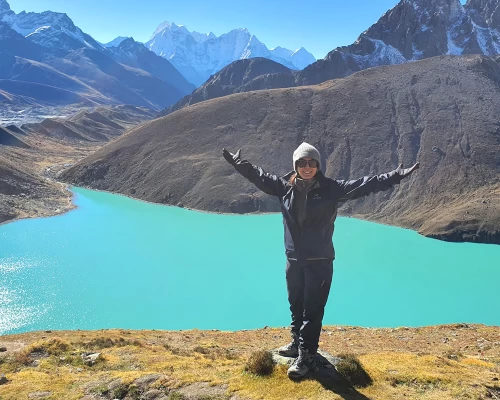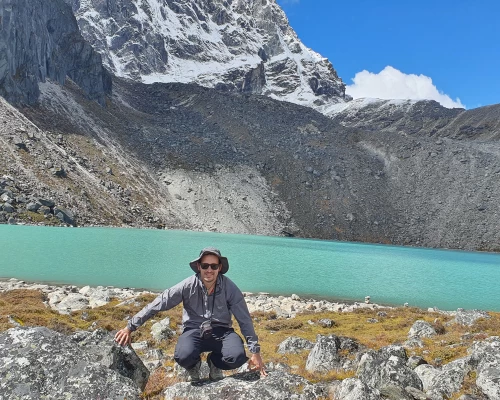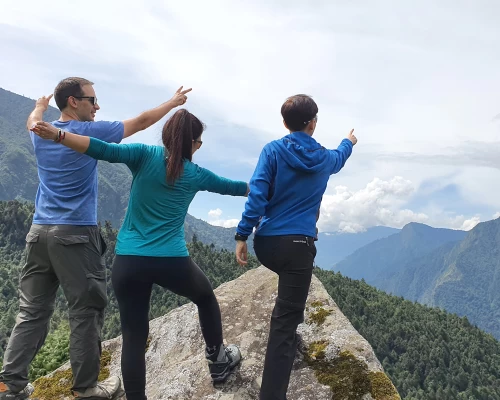Trek Grade

The Everest Three High Passes Trek is considered a challenging trek, with the trail encompassing three passes of the Khumbu region- Renjo La Pass, Cho La Pass, and Kongma La Pass. Traversing the Renjo La Pass with steep ascent and descent tests the skill and endurance of trekkers. Likewise, the glaciated Cho la pass at 5420 m requires trekkers to make their way through potential icy sections and crevasses. Furthermore, Kongma La Pass, which is considered a bit more difficult than other passes, requires trekkers to traverse through moraines and rocky terrain with winding, steep ascents and descents.
Altitudes rising more than 5000m bring their own challenges, including altitude-related risks and possibilities. Furthermore, covering a significant distance of 133 km over a period of 16 to 20 days requires a good level of physical fitness, prior trekking experience, and a mindset for long days of walking that span from 6 to 8 hours per day. Despite all the difficulties and challenges, this adventurous trek offers you an unforgettable Himalayan experience with awe-inspiring moments at every step.
Best Season for the Everest Three High Passes Trek

Spring (March to May) and autumn (September to November) are considered favorable seasons for the Everest Three High Passes Trek. The weather warming up with dormancy of active flora and fauna during spring makes it one of the best seasons for the trek. Likewise, the pleasant weather, along with festival delights in the Khumbu region during autumn, adorn the perfect trekking atmosphere.
The clear blue skies with unobstructed views of the mountains, along with low possibilities of precipitation and snowfall, bring out the best of the Everest Three High Passes Trek. However, if you plan your trek in the monsoon or winter season, then you will have to go through weather-related difficulties to complete the trek. The heavy downpour during monsoon season increases the chances of floods and landslides. Likewise, the frozen path, along with icy sections during winter, can make the crossing of passes nearly impossible. So, it is very important to plan your trek by considering the weather and climate of the Everest region.
Is Everest Three High Passes Trek Suitable For Me?

After knowing about the difficulties and challenges you may face during the trek, you may be in a dilemma if this trek is suitable for you or not. If you have prior high-altitude trekking experience with a good level of physical and mental fitness, then you are all set for the trek. In case you have health issues regarding heart, lungs, joints, etc then it is better to consult with your doctor first.
While choosing the package, make sure you opt for the package with acclimatization days. This will give your body enough time to adapt to lower oxygen levels, and you can avoid altitude sickness. It is recommended to take some physical training 4 to 6 weeks before trekking to be fully prepared for the trek. Along with physical fitness, mental stability during the trek is a must. So, you must set a mindset of adaptability and long hours of walking in unfamiliar places.
Guides and Porters
Having guides and porters by your side during the trek enhances your experience to a great extent. Guides will help you to navigate the routes along with providing you with necessary information on the history, culture, and tradition of the region. Likewise, they will act as a mediator between you and the locals, which will somewhat reduce the communication barrier.
Likewise, you are not used to carrying heavy weight and walking back and forth in the rugged landscapes. So, a porter will carry the luggage of two trekkers, which will lift the burden of luggage from your back, and you can enjoy the trek to the fullest.
Insurance
Before walking on the trails of Everest High Passes, it is very important to take travel insurance. These insurance policies will act as a medium to reduce your financial burden and shift the risk to the insurer. However, it is necessary to carry the policy that covers all your medical expenses, hospital bills, evacuation expenses, and air ambulance. It is recommended to add the clause of cancellation to your policy which will make your plan flexible.
How to Cope with Altitude Sickness?

You will spend most days of the trek above 3000 m, so it is natural to have the pathological effect of altitude sickness. However, to avoid AMS, your body must acclimatize properly. You will need to go on side hikes and adapt your body to the lower oxygen level. Do not consume hard drinks and high consumption of tea and coffee, since it will hinder your acclimatization process.
Likewise, you need to take short breaks to catch your breath during the trek. Make sure you carry basic medications for altitude sickness to reduce its effect. Moreover, you will need to take the trek slowly at your pace and intake at least 3 to 4 liters of water daily. Having nutritious meals along with good sleep also helps you to avoid altitude sickness.
You May Also Like:














